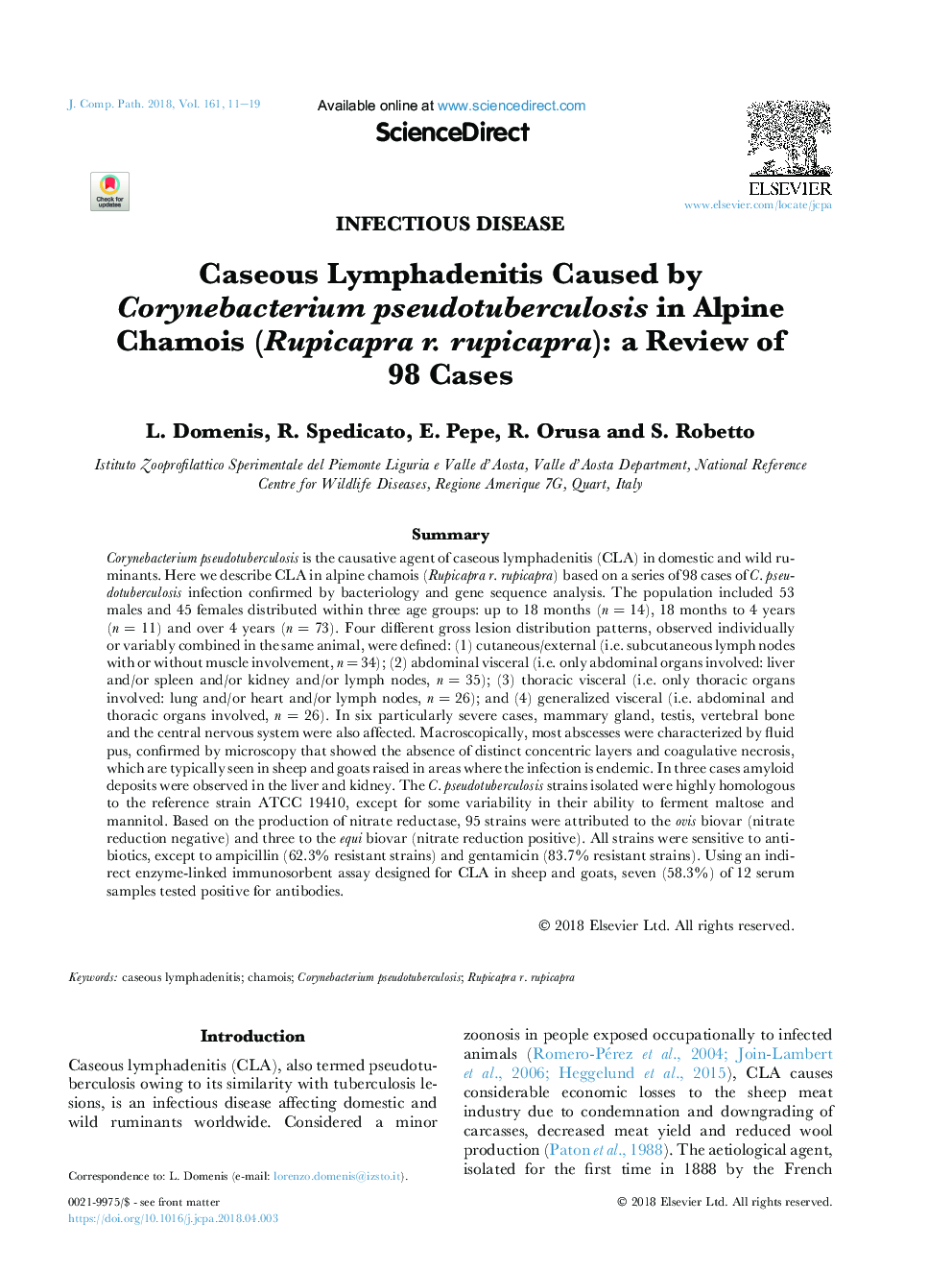| کد مقاله | کد نشریه | سال انتشار | مقاله انگلیسی | نسخه تمام متن |
|---|---|---|---|---|
| 8500406 | 1553750 | 2018 | 9 صفحه PDF | دانلود رایگان |
عنوان انگلیسی مقاله ISI
Caseous Lymphadenitis Caused by Corynebacterium pseudotuberculosis in Alpine Chamois (Rupicapra r. rupicapra): a Review of 98 Cases
دانلود مقاله + سفارش ترجمه
دانلود مقاله ISI انگلیسی
رایگان برای ایرانیان
کلمات کلیدی
موضوعات مرتبط
علوم زیستی و بیوفناوری
علوم کشاورزی و بیولوژیک
علوم دامی و جانورشناسی
پیش نمایش صفحه اول مقاله

چکیده انگلیسی
Corynebacterium pseudotuberculosis is the causative agent of caseous lymphadenitis (CLA) in domestic and wild ruminants. Here we describe CLA in alpine chamois (Rupicapra r. rupicapra) based on a series of 98 cases of C. pseudotuberculosis infection confirmed by bacteriology and gene sequence analysis. The population included 53 males and 45 females distributed within three age groups: up to 18 months (n = 14), 18 months to 4 years (n = 11) and over 4 years (n = 73). Four different gross lesion distribution patterns, observed individually or variably combined in the same animal, were defined: (1) cutaneous/external (i.e. subcutaneous lymph nodes with or without muscle involvement, n = 34); (2) abdominal visceral (i.e. only abdominal organs involved: liver and/or spleen and/or kidney and/or lymph nodes, n = 35); (3) thoracic visceral (i.e. only thoracic organs involved: lung and/or heart and/or lymph nodes, n = 26); and (4) generalized visceral (i.e. abdominal and thoracic organs involved, n = 26). In six particularly severe cases, mammary gland, testis, vertebral bone and the central nervous system were also affected. Macroscopically, most abscesses were characterized by fluid pus, confirmed by microscopy that showed the absence of distinct concentric layers and coagulative necrosis, which are typically seen in sheep and goats raised in areas where the infection is endemic. In three cases amyloid deposits were observed in the liver and kidney. The C. pseudotuberculosis strains isolated were highly homologous to the reference strain ATCC 19410, except for some variability in their ability to ferment maltose and mannitol. Based on the production of nitrate reductase, 95 strains were attributed to the ovis biovar (nitrate reduction negative) and three to the equi biovar (nitrate reduction positive). All strains were sensitive to antibiotics, except to ampicillin (62.3% resistant strains) and gentamicin (83.7% resistant strains). Using an indirect enzyme-linked immunosorbent assay designed for CLA in sheep and goats, seven (58.3%) of 12 serum samples tested positive for antibodies.
ناشر
Database: Elsevier - ScienceDirect (ساینس دایرکت)
Journal: Journal of Comparative Pathology - Volume 161, May 2018, Pages 11-19
Journal: Journal of Comparative Pathology - Volume 161, May 2018, Pages 11-19
نویسندگان
L. Domenis, R. Spedicato, E. Pepe, R. Orusa, S. Robetto,